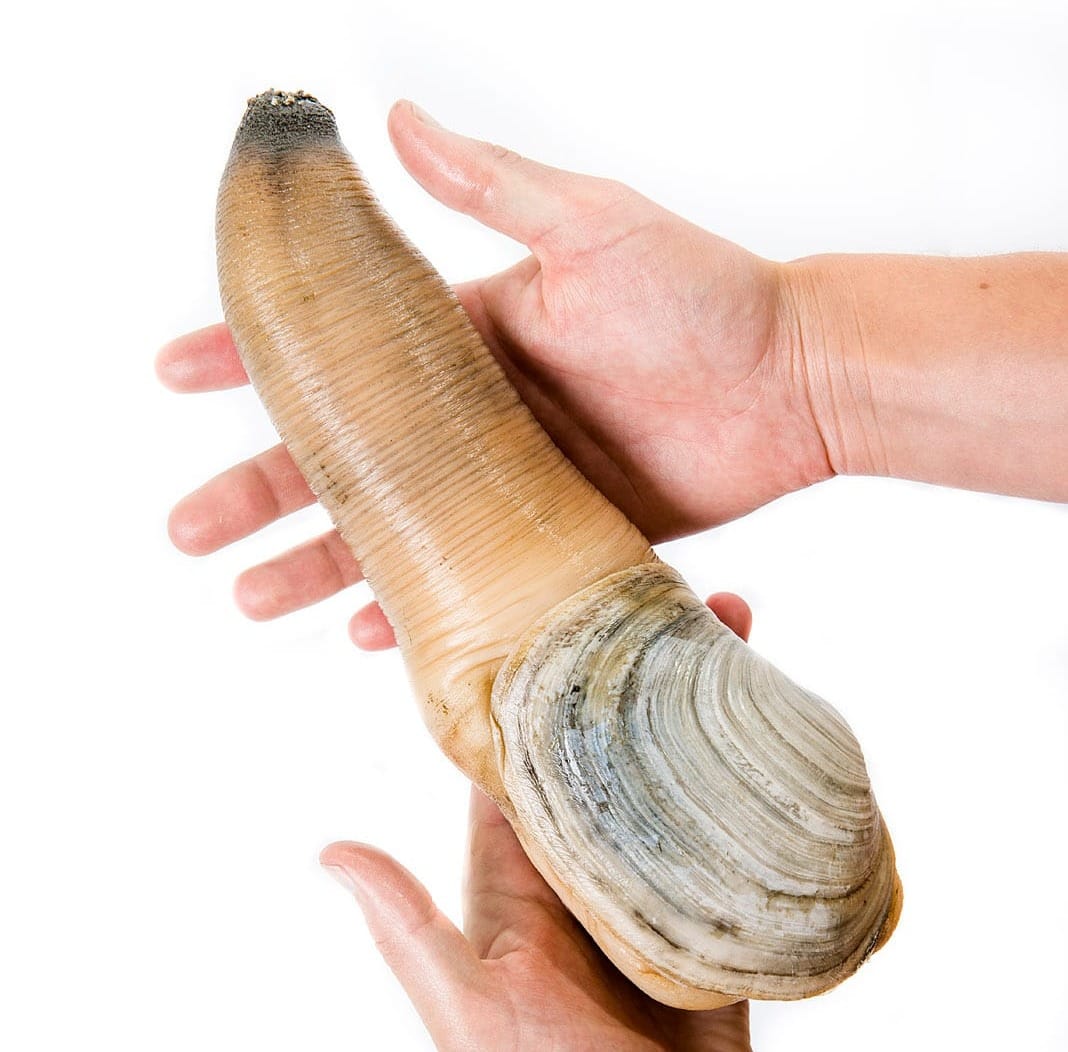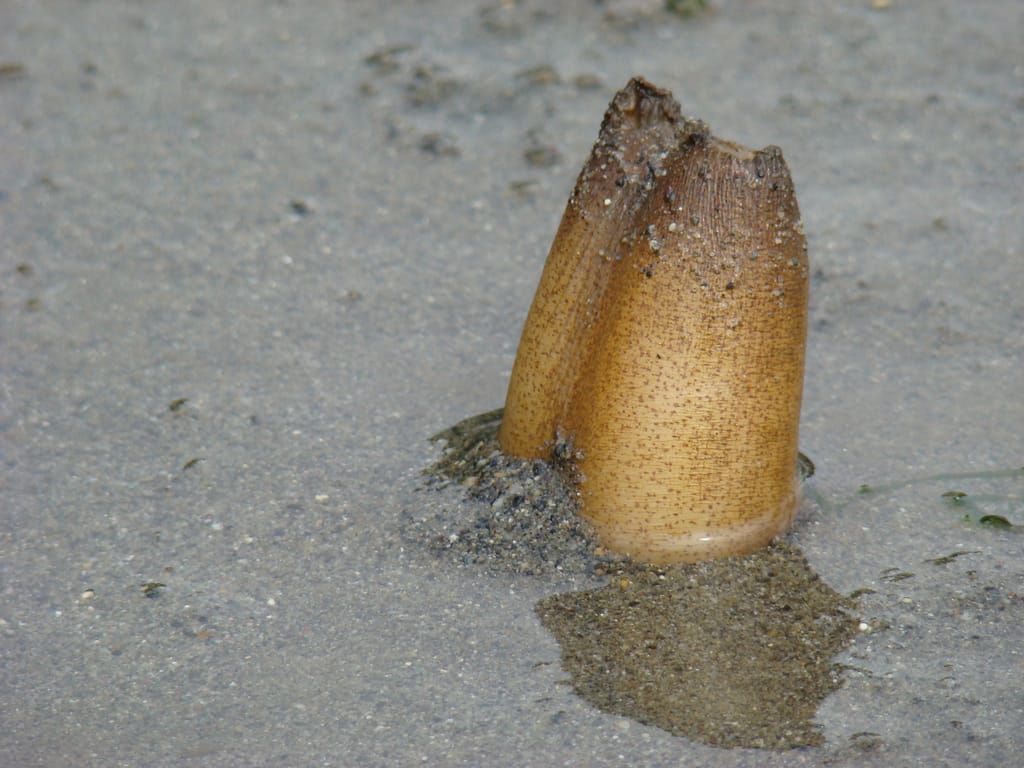Geoduck: Everything You Need To Know
The geoduck is known for its impressive size, longevity, and high reproductive capacity. These traits make sustainable management crucial for aquaculture and wild harvest.

The Pacific geoduck (Panopea generosa), pronounced “gooey-duck,” is a large clam native to the temperate Pacific Ocean and subtropical waters of the Mexican Pacific.
Its range stretches along the west coast of North America, from Alaska to Punta Canoas in Baja California.
More recently, geoducks have been observed further south near Guerrero Negro in Baja California Sur, likely due to efforts to expand aquaculture operations.
In the United States, Washington State is a hub for geoduck farming, particularly in southern Puget Sound, where both wild harvesting and aquaculture industries are well-established.
These clams are easily identified by their small shells and long siphons, or “necks,” which can extend several feet beyond the shell.

The siphon has two openings—one for drawing in oxygen and phytoplankton and another for expelling water.
Geoducks are remarkable for their longevity, with some individuals living as long as 168 years. They burrow into sediment at a rate of about one foot per year, eventually reaching depths of up to three feet.
Geoducks experience significant growth during their early years, reaching about 1.5 pounds within three to five years.
However, they may take up to 15 years to reach their maximum size of approximately 7 pounds.
Reproduction is another notable feature, with female geoducks releasing between 1 and 2 million eggs per spawning cycle.
Their unique characteristics, combined with their long lifespan and high reproductive capacity, highlight the need for careful management to support sustainable aquaculture and wild harvesting practices.
Habitat
Pacific geoduck clams are fascinating infaunal creatures, meaning they live buried within the substrate of shallow subtidal waters, typically at depths ranging from 5 to 25 meters.
These depths provide a stable environment with limited exposure to predators and environmental disturbances. The name "geoduck" originates from the Salish word gweduc, which translates to "to dig deep," reflecting their remarkable burrowing behavior.
In their larval stage, Pacific geoduck clams are planktonic, drifting freely in the water column.
During this phase, they rely on ocean currents for dispersal. Once they transition to the juvenile stage, they settle into the seabed and adopt an infaunal lifestyle, burrowing deep into substrates composed of mud, sand, and gravel.
The depth and density of the substrate are crucial for their protection and growth, as these clams can burrow up to a meter into the sediment, with only their siphons extending to the surface for feeding and respiration.
Pacific geoducks are highly adaptable to a wide range of environmental conditions.
Adults demonstrate remarkable tolerance to variations in salinity and temperature, allowing them to inhabit diverse marine ecosystems.
However, they are predominantly found in temperate coastal waters, where stable conditions support their growth and reproductive cycles.
The clams thrive in areas with a moderate current, which helps bring nutrient-rich water for filter feeding, while also preventing sediment accumulation that could hinder their siphon extension.
Physical Description of Pacific Geoduck Clams
Size and Dimensions
Their average shell length typically ranges between 135 to 140 mm, with exceptional specimens exceeding 200 mm in length.
Despite their massive size, the shells are relatively thin compared to other bivalves.
A full-grown Pacific geoduck can weigh over 3 kilograms, including the body and the shell.
This substantial mass is largely due to their elongated siphon, which can extend more than 1 meter beyond the shell, allowing the clam to access food and oxygen from the seabed surface while remaining deeply buried.
Shell Features
The shell of the Pacific geoduck is generally quadrate or square-shaped, a feature that distinguishes it from other clams.
It has a light brown outer covering called the periostracum, a thin protective layer that shields the shell from erosion and environmental wear. The interior of the shell is smooth and often white or pale cream in color, which reflects its adaptation to a burrowing lifestyle.
The shell may show slight variations in texture and thickness depending on environmental factors, such as water salinity, temperature, and the composition of the seabed.
Siphon Structure
The siphon is the most striking feature of the Pacific geoduck, accounting for its unique appearance and functionality.
The siphon, or "neck," consists of two tubes: one for intake (drawing in seawater for feeding and respiration) and another for expelling waste and water.
It is covered in soft tissue and can extend well over a meter. Unlike other clams, the siphon of the geoduck is too large to retract fully into the shell, a characteristic that sets it apart from most bivalves.
Sexual Dimorphism and Reproductive Traits
Externally, there are no visible differences between male and female Pacific geoducks.
Their sexes can only be determined through microscopic examination of the gonads. Males tend to reach sexual maturity at a younger age and smaller size compared to females.
Both sexes play a crucial role in reproduction, which occurs via broadcast spawning, where eggs and sperm are released into the water column.
Environmental Influences on Physical Traits
The size, color, and shape of geoduck shells are influenced by environmental conditions.
Variations in water chemistry, such as the availability of calcium carbonate, impact shell thickness and growth rate.
Substrate composition also plays a role; softer sediments may lead to thinner shells, while more abrasive substrates can result in thicker shells due to constant wear.
Additionally, water temperature can affect metabolic rates and, consequently, growth rates and body mass.
Adaptations to a Burrowing Lifestyle
Pacific geoduck clams are well-adapted to a sedentary life beneath the seabed.
Their long siphon allows them to efficiently filter feed and respire while buried deep in the substrate. This adaptation helps them evade predators and thrive in environments with variable sediment compositions.
Developmental Stages
This giant clam progress through seven well-defined developmental stages typical of bivalve species: egg, trochophore larva, prodissoconch (veliger) I, prodissoconch (veliger) II, dissoconch (post-larval), juvenile, and adult.
This life cycle involves both free-swimming and sedentary phases, adapting the clam to its infaunal lifestyle.
Egg and Trochophore Larva
The life cycle begins with spawning and external fertilization, where the fertilized eggs undergo rapid cell division to develop into trochophore larvae.
These larvae are free-swimming and shaped like spinning tops, equipped with short cilia for movement. During this planktonic stage, they drift in the water column and rely on cilia for mobility and feeding.
Prodissoconch (Veliger) I
Within approximately two days of hatching, the trochophore larvae develop a straight-hinged shell and a specialized ciliated structure called a velum, used for swimming and feeding.
This stage, referred to as prodissoconch I, marks the transition to a more structured larval form. The velum enhances the larvae's ability to move through the plankton and capture food particles.
Prodissoconch (Veliger) II
As the larvae grow, they progress to the prodissoconch II stage, during which their shells develop small rounded protrusions known as umbones at the hinge.
These umbones signal the beginning of shell differentiation. Around 16 days post-hatching, the larvae lose their velum, ending their swimming capability and initiating a shift toward a benthic lifestyle.
Dissoconch (Post-Larval Stage)
At the dissoconch stage, the larvae start to develop features that prepare them for life on the seafloor. They grow spines along the edges of their shells and a muscular foot, which they use for crawling and burrowing.
Transitioning from a planktonic to a sessile existence, these young clams attach to the substrate using byssal threads and begin to dig into the sediment with their foot.
Juvenile Stage
As they continue to grow, the clams enter the juvenile stage, where they begin to resemble adults.
During this phase, they develop their distinctive siphon, enabling deeper burrowing into the substrate for protection and feeding. Juveniles are more mobile than adults, using their foot to reposition themselves as needed.
Adult Stage
By around three years of age, with a shell length of approximately 75 mm, Pacific geoduck clams reach sexual maturity.
They experience rapid growth until about 10 years old, after which growth slows but does not cease, as they exhibit indeterminate growth.
Mature adults are fully sedentary, losing their ability to dig, and rely entirely on their siphon for feeding and respiration while buried deep in the substrate.
Characteristic
Pacific geoduck clams are burrowing mollusks found up to 3 feet deep in intertidal and subtidal zones along the northwestern U.S. coast.
During their larval stage, they are motile and move freely within the water column. As post-larval dissoconchs, they develop a ciliated foot for crawling and burrowing into sand or mud, and they release byssal threads to anchor themselves to the substrate.
Juveniles burrow deeper as they grow, leaving only their siphon exposed above the surface. As adults, their siphons elongate while their feet shrink proportionally, limiting further movement and making them largely sedentary.
Role in the Ecosystem
Pacific geoduck clams make up a significant portion of infaunal biomass in their habitats and play a key role in ecosystem processes.
By filtering 7 to 20 liters of water per hour, they help regulate phytoplankton levels and alter water column compounds.
Additionally, they act as biodepositors by releasing waste, which enriches the surrounding environment with nutrients like nitrogen, benefiting nearby aquatic plants.
These clams also serve as a vital food source for various predators, including fish, crabs, and other marine invertebrates.
Known predators
- Sea stars - Predominantly preying on juveniles and newly settled geoducks.
- Crabs - Such as Dungeness crabs, which feed on younger and smaller geoducks.
- Fish - Various fish species consume geoduck larvae and juveniles.
- Sea otters - Known for their ability to dig up adult geoducks buried in the substrate.
- Humans - One of the most significant predators, harvesting adult geoducks for commercial and recreational purposes.
- Diving ducks - Occasionally feed on siphons or exposed parts of geoducks.
These predators highlight the geoduck’s ecological role as an important food source within marine environments.


